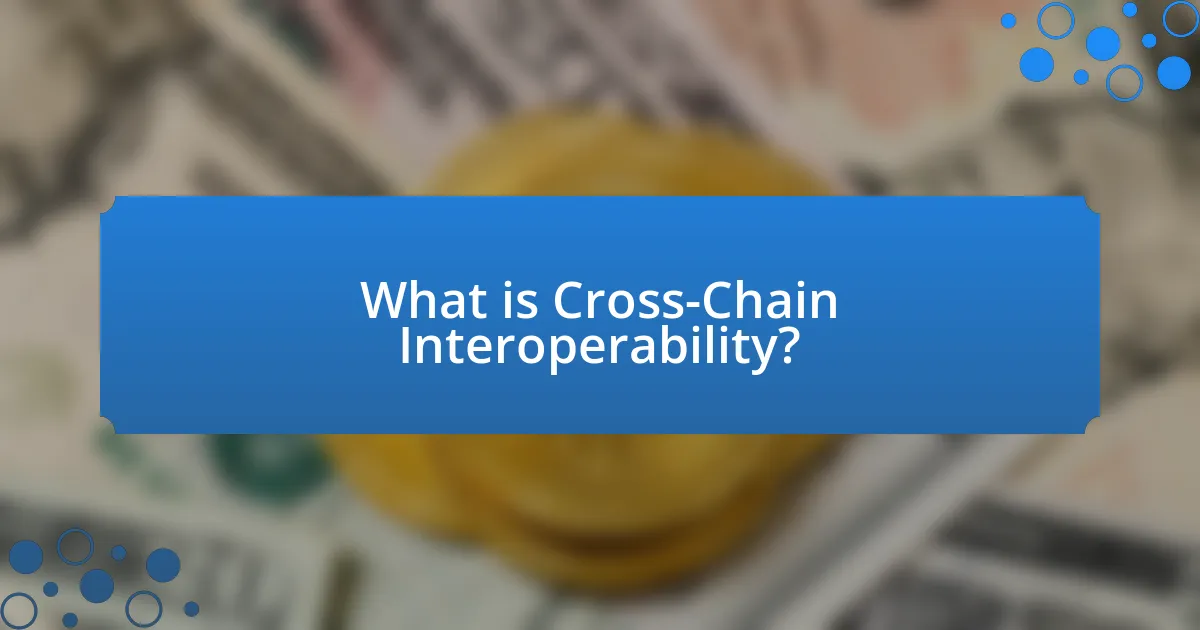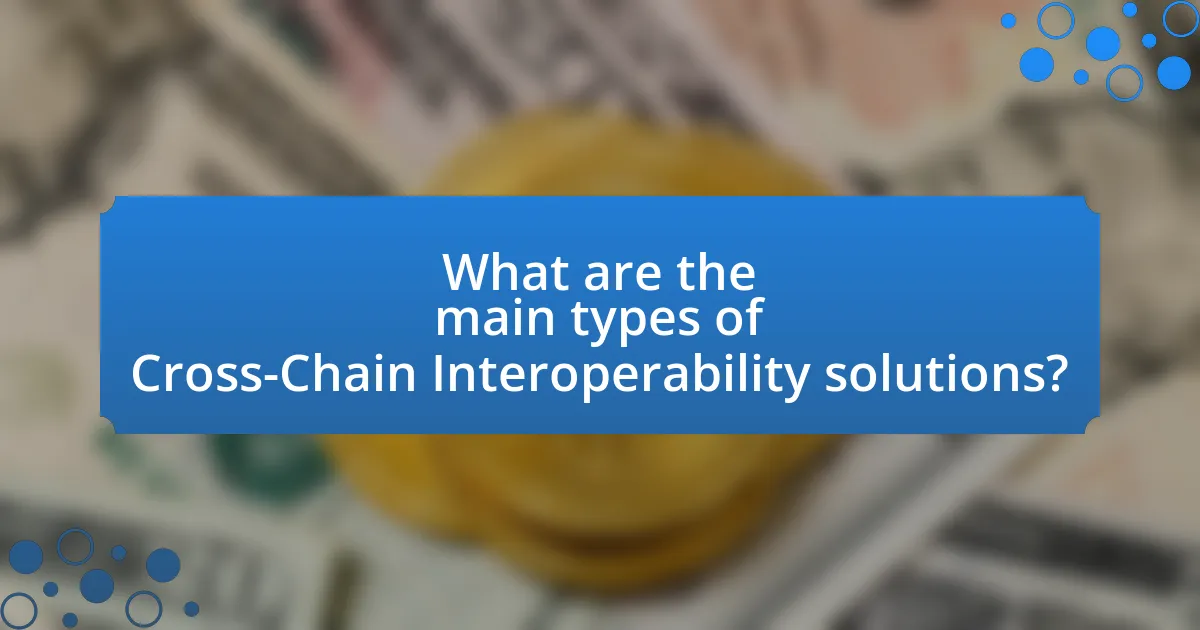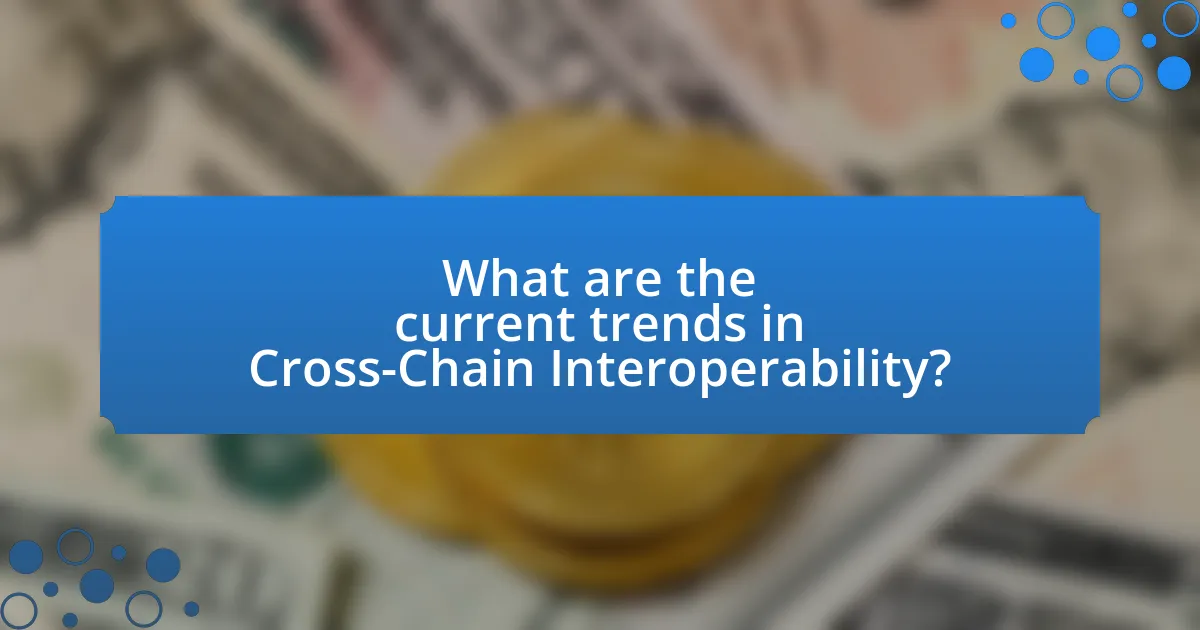Cross-chain interoperability refers to the capability of different blockchain networks to communicate and interact seamlessly, allowing for the transfer of assets and data across various ecosystems. This article explores the mechanisms that enable cross-chain interoperability, including atomic swaps, cross-chain bridges, and interoperability protocols like Polkadot and Cosmos. It highlights the importance of cross-chain solutions in enhancing liquidity, user experience, and scalability within the blockchain ecosystem, while also addressing the challenges and security considerations associated with these technologies. Additionally, the article discusses current trends in decentralized finance (DeFi) and the future prospects for cross-chain interoperability as the demand for interconnected blockchain solutions continues to grow.

What is Cross-Chain Interoperability?
Cross-chain interoperability refers to the ability of different blockchain networks to communicate and interact with one another seamlessly. This capability allows for the transfer of assets and data across disparate blockchain ecosystems, enhancing functionality and user experience. For instance, projects like Polkadot and Cosmos utilize specific protocols to facilitate this interaction, enabling decentralized applications to operate across multiple chains. The significance of cross-chain interoperability lies in its potential to create a more connected and efficient blockchain landscape, thereby increasing liquidity and expanding the use cases for blockchain technology.
How does Cross-Chain Interoperability function?
Cross-Chain Interoperability functions by enabling different blockchain networks to communicate and exchange data or assets seamlessly. This is achieved through protocols and technologies such as atomic swaps, cross-chain bridges, and interoperability frameworks like Polkadot and Cosmos, which facilitate the transfer of tokens and information across disparate blockchains. For instance, atomic swaps allow users to exchange cryptocurrencies from different blockchains without the need for a centralized exchange, ensuring security and trustlessness. Additionally, cross-chain bridges connect two or more blockchains, allowing assets to move freely between them while maintaining their original properties. These mechanisms are essential for creating a more interconnected blockchain ecosystem, enhancing usability and expanding the potential applications of blockchain technology.
What are the key technologies enabling Cross-Chain Interoperability?
The key technologies enabling Cross-Chain Interoperability include atomic swaps, cross-chain bridges, and interoperability protocols like Polkadot and Cosmos. Atomic swaps allow for the direct exchange of assets between different blockchains without intermediaries, enhancing liquidity and reducing reliance on centralized exchanges. Cross-chain bridges facilitate the transfer of tokens and data across different blockchain networks, enabling seamless interaction and collaboration. Interoperability protocols, such as Polkadot’s parachains and Cosmos’s zones, create a framework for multiple blockchains to communicate and share information, fostering a more interconnected blockchain ecosystem. These technologies collectively enhance the functionality and usability of decentralized applications across various blockchain platforms.
How do different blockchain protocols interact in Cross-Chain Interoperability?
Different blockchain protocols interact in Cross-Chain Interoperability through mechanisms such as atomic swaps, cross-chain bridges, and interoperability protocols like Polkadot and Cosmos. Atomic swaps allow users to exchange assets across different blockchains without intermediaries, ensuring trustless transactions. Cross-chain bridges facilitate the transfer of tokens and data between distinct blockchain networks, enabling seamless interaction. Interoperability protocols, such as Polkadot’s parachains and Cosmos’s zones, create a framework for multiple blockchains to communicate and share information efficiently. These methods enhance the overall functionality and usability of blockchain ecosystems, allowing for a more integrated and versatile digital economy.
Why is Cross-Chain Interoperability important?
Cross-chain interoperability is important because it enables different blockchain networks to communicate and share data seamlessly. This capability enhances the overall functionality of blockchain ecosystems by allowing assets and information to move freely across various platforms, thereby increasing liquidity and user engagement. For instance, according to a report by the World Economic Forum, cross-chain solutions can potentially unlock trillions of dollars in value by facilitating transactions and interactions that were previously siloed within individual blockchains. This interconnectedness fosters innovation, improves scalability, and supports the development of decentralized applications that can leverage multiple blockchain features simultaneously.
What challenges does Cross-Chain Interoperability address in the blockchain ecosystem?
Cross-Chain Interoperability addresses several challenges in the blockchain ecosystem, primarily the lack of communication between different blockchain networks. This limitation hinders the seamless transfer of assets and data across platforms, resulting in siloed ecosystems that restrict user access and functionality. Additionally, Cross-Chain Interoperability tackles issues related to scalability, as it allows for the distribution of transactions across multiple chains, thereby reducing congestion on any single network. Furthermore, it enhances security by enabling decentralized exchanges and cross-chain smart contracts, which minimize the risks associated with centralized intermediaries. These solutions are essential for fostering a more integrated and efficient blockchain environment, as evidenced by the increasing adoption of interoperability protocols like Polkadot and Cosmos, which facilitate cross-chain interactions and improve overall network utility.
How does Cross-Chain Interoperability enhance user experience?
Cross-Chain Interoperability enhances user experience by allowing seamless transactions and interactions across different blockchain networks. This capability enables users to transfer assets and data without being confined to a single blockchain, thus increasing flexibility and accessibility. For instance, users can leverage the strengths of various blockchains, such as speed, cost-effectiveness, or specific functionalities, leading to a more efficient and tailored experience. Additionally, studies show that interoperability can reduce transaction times and costs, further improving user satisfaction and engagement in decentralized applications.

What are the main types of Cross-Chain Interoperability solutions?
The main types of Cross-Chain Interoperability solutions are atomic swaps, cross-chain bridges, and interoperability protocols. Atomic swaps allow users to exchange cryptocurrencies across different blockchains without intermediaries, enhancing security and efficiency. Cross-chain bridges facilitate the transfer of assets between distinct blockchain networks, enabling users to leverage the unique features of each chain. Interoperability protocols, such as Polkadot and Cosmos, create a framework for multiple blockchains to communicate and share data seamlessly, promoting a more interconnected blockchain ecosystem. These solutions are essential for enhancing the functionality and usability of decentralized applications across various blockchain platforms.
How do atomic swaps facilitate Cross-Chain transactions?
Atomic swaps facilitate cross-chain transactions by enabling the direct exchange of cryptocurrencies between different blockchains without the need for intermediaries. This is achieved through the use of smart contracts that ensure both parties fulfill their obligations before the transaction is completed, thus eliminating the risk of one party defaulting. For instance, if Alice wants to exchange Bitcoin for Ethereum with Bob, an atomic swap allows them to lock their respective funds in a smart contract. The contract will only release the funds to each party if both parties provide the correct cryptographic proof of the transaction, ensuring that either both transactions occur or neither does. This mechanism enhances security and trust in cross-chain transactions, as evidenced by the implementation of atomic swaps in various blockchain projects, such as the Lightning Network and Decred, which demonstrate their practical application and effectiveness in facilitating seamless cryptocurrency exchanges across different networks.
What are the advantages and limitations of atomic swaps?
Atomic swaps offer the advantage of enabling direct peer-to-peer exchanges of cryptocurrencies across different blockchains without the need for intermediaries. This feature enhances security and reduces the risk of fraud, as the transaction is executed only if both parties fulfill their obligations, ensuring trustless exchanges. Additionally, atomic swaps can lower transaction fees compared to traditional exchanges, as they eliminate the need for centralized platforms.
However, atomic swaps also have limitations. They require both parties to be online simultaneously, which can complicate the process and lead to potential delays. Furthermore, the technology is still relatively new and may not be supported by all cryptocurrencies, limiting its applicability. Additionally, the complexity of the underlying technology can pose challenges for users who are not technically savvy, potentially hindering widespread adoption.
How do atomic swaps compare to other interoperability methods?
Atomic swaps enable direct peer-to-peer exchanges of cryptocurrencies across different blockchains without intermediaries, making them distinct from other interoperability methods like centralized exchanges or wrapped tokens. Unlike centralized exchanges, which require trust in a third party and involve custodial risks, atomic swaps maintain user control over funds throughout the transaction process. Additionally, wrapped tokens, while facilitating cross-chain transactions, introduce complexities such as reliance on the issuing platform and potential security vulnerabilities. Atomic swaps, therefore, provide a trustless and decentralized alternative, enhancing security and user autonomy in cross-chain transactions.
What role do bridges play in Cross-Chain Interoperability?
Bridges facilitate Cross-Chain Interoperability by enabling the transfer of assets and data between different blockchain networks. They act as connectors that allow users to move tokens or information from one blockchain to another, thereby enhancing the functionality and usability of decentralized applications across multiple platforms. For instance, a bridge can allow Ethereum-based tokens to be used on a Binance Smart Chain application, effectively expanding the ecosystem and user options. This interoperability is crucial for the growth of decentralized finance (DeFi) and other blockchain applications, as it promotes liquidity and user engagement across various networks.
How do bridges ensure security in Cross-Chain transactions?
Bridges ensure security in cross-chain transactions by utilizing mechanisms such as smart contracts, cryptographic proofs, and multi-signature wallets. Smart contracts automate the process of locking and releasing assets across different blockchains, ensuring that funds are only transferred when specific conditions are met. Cryptographic proofs, such as zero-knowledge proofs, verify the authenticity of transactions without revealing sensitive information, enhancing privacy and security. Multi-signature wallets require multiple private keys to authorize a transaction, reducing the risk of unauthorized access. These combined methods create a secure environment for cross-chain interactions, minimizing the potential for fraud or loss of assets.
What are the different types of bridges used in Cross-Chain Interoperability?
The different types of bridges used in Cross-Chain Interoperability include centralized bridges, decentralized bridges, and hybrid bridges. Centralized bridges rely on a trusted third party to facilitate transactions between different blockchains, ensuring security but introducing a single point of failure. Decentralized bridges utilize smart contracts and consensus mechanisms to allow users to interact directly with multiple blockchains, enhancing security and reducing reliance on intermediaries. Hybrid bridges combine elements of both centralized and decentralized models, aiming to balance efficiency and security. Each type of bridge serves to enable seamless asset transfers and communication across diverse blockchain networks, thereby enhancing interoperability.

What are the current trends in Cross-Chain Interoperability?
Current trends in cross-chain interoperability include the rise of decentralized finance (DeFi) protocols that facilitate asset transfers across different blockchain networks, the development of interoperability-focused blockchain platforms like Polkadot and Cosmos, and the increasing adoption of cross-chain bridges that enhance liquidity and user experience. These trends are driven by the need for seamless communication between disparate blockchain ecosystems, enabling users to leverage the unique features of various networks while maintaining asset security. For instance, the total value locked in cross-chain DeFi protocols has surged, indicating a growing demand for interoperability solutions that allow users to move assets freely across chains.
How are decentralized finance (DeFi) platforms utilizing Cross-Chain Interoperability?
Decentralized finance (DeFi) platforms are utilizing cross-chain interoperability to enhance liquidity and expand user access across multiple blockchain networks. By implementing protocols such as atomic swaps and wrapped tokens, DeFi platforms enable seamless asset transfers and interactions between different blockchains. For instance, projects like Polkadot and Cosmos facilitate cross-chain communication, allowing DeFi applications to leverage the unique features of various blockchains while maintaining security and decentralization. This interoperability not only increases the efficiency of transactions but also broadens the market reach, as users can engage with diverse financial products without being restricted to a single blockchain ecosystem.
What impact does Cross-Chain Interoperability have on liquidity in DeFi?
Cross-Chain Interoperability significantly enhances liquidity in Decentralized Finance (DeFi) by enabling assets to move seamlessly across different blockchain networks. This interoperability allows users to access a broader range of liquidity pools and trading opportunities, thereby increasing the overall capital efficiency within the DeFi ecosystem. For instance, platforms like Polkadot and Cosmos facilitate cross-chain transactions, which can lead to a more diverse set of assets being available for trading and lending, ultimately attracting more users and capital. As a result, the total value locked (TVL) in DeFi protocols has shown substantial growth, reflecting the positive impact of cross-chain capabilities on liquidity.
How are Cross-Chain solutions evolving in response to market demands?
Cross-Chain solutions are evolving by enhancing interoperability, scalability, and user experience to meet increasing market demands for seamless asset transfers and decentralized applications. As the blockchain ecosystem expands, the need for different networks to communicate effectively has led to the development of protocols like Polkadot and Cosmos, which facilitate cross-chain interactions. These solutions are also integrating advanced technologies such as atomic swaps and bridges, allowing for secure and efficient transactions across various blockchains. The rise in decentralized finance (DeFi) and non-fungible tokens (NFTs) has further accelerated this evolution, as users seek to leverage assets across multiple platforms, driving innovation in cross-chain technology.
What are the future prospects for Cross-Chain Interoperability?
The future prospects for cross-chain interoperability are highly promising, as advancements in blockchain technology continue to facilitate seamless communication between different networks. Projects like Polkadot and Cosmos are leading the way by enabling diverse blockchains to interoperate, which enhances scalability and user experience. According to a report by Gartner, the demand for cross-chain solutions is expected to grow significantly, with a projected increase in decentralized finance (DeFi) applications that require interoperability. This trend indicates a shift towards a more interconnected blockchain ecosystem, where assets and data can move freely across platforms, ultimately driving innovation and adoption in the cryptocurrency space.
How might advancements in technology influence Cross-Chain Interoperability?
Advancements in technology will significantly enhance Cross-Chain Interoperability by enabling seamless communication and data exchange between different blockchain networks. For instance, the development of protocols like Polkadot and Cosmos facilitates interoperability by allowing multiple blockchains to share information and assets securely. Additionally, improvements in decentralized oracles, such as Chainlink, provide reliable data feeds across chains, further bridging gaps between ecosystems. These technological innovations not only streamline transactions but also foster a more integrated blockchain environment, as evidenced by the increasing number of projects adopting interoperability solutions to enhance user experience and expand functionality.
What potential challenges could arise as Cross-Chain Interoperability evolves?
Potential challenges that could arise as Cross-Chain Interoperability evolves include security vulnerabilities, scalability issues, and regulatory compliance hurdles. Security vulnerabilities may emerge due to the complexity of connecting multiple blockchains, increasing the risk of attacks such as double-spending or smart contract exploits. Scalability issues can arise as the demand for cross-chain transactions grows, potentially leading to network congestion and slower transaction times. Regulatory compliance hurdles may also become significant, as different jurisdictions have varying regulations regarding cryptocurrencies and blockchain technology, complicating the legal landscape for cross-chain solutions.
What best practices should be followed when implementing Cross-Chain Interoperability solutions?
When implementing Cross-Chain Interoperability solutions, it is essential to prioritize security, scalability, and user experience. Security measures must include robust cryptographic protocols to prevent vulnerabilities during asset transfers between chains. Scalability is crucial, as the solution should handle increasing transaction volumes without compromising performance; for instance, utilizing layer-2 solutions can enhance throughput. Additionally, ensuring a seamless user experience involves creating intuitive interfaces and clear documentation to facilitate user engagement. These best practices are supported by industry standards and frameworks, such as the Interledger Protocol, which emphasizes secure and efficient cross-chain transactions.
How can developers ensure security in Cross-Chain transactions?
Developers can ensure security in Cross-Chain transactions by implementing robust cryptographic protocols and utilizing decentralized oracles. Cryptographic protocols, such as zero-knowledge proofs, enhance privacy and integrity by allowing one party to prove knowledge of a value without revealing it. Decentralized oracles facilitate secure data transfer between blockchains by providing reliable off-chain data feeds, reducing the risk of manipulation. Additionally, employing multi-signature wallets can enhance transaction security by requiring multiple approvals before execution, thereby mitigating the risk of single-point failures. These methods collectively strengthen the security framework necessary for safe Cross-Chain transactions.
What considerations should businesses keep in mind when adopting Cross-Chain solutions?
Businesses should consider security, scalability, and regulatory compliance when adopting Cross-Chain solutions. Security is paramount, as vulnerabilities in cross-chain protocols can expose assets to risks; for instance, the 2022 Ronin Network hack, which resulted in a loss of $620 million, highlights the importance of robust security measures. Scalability is crucial, as businesses must ensure that the cross-chain solution can handle increased transaction volumes without compromising performance; Ethereum’s transition to a proof-of-stake model aims to address scalability issues. Regulatory compliance is also essential, as businesses must navigate varying regulations across jurisdictions, which can impact the legality and operational aspects of cross-chain transactions.


